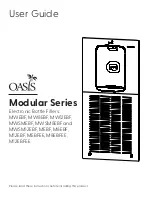
3
Electric arc welding produces toxic fumes.
Provide adequate ventilation in the welding area at all times.
Do not weld on galvanized zinc, cadmium, or lead beryllium materials unless you are POSITIVE that sufficient
ventilation is provided. These materials produce toxic fumes.
Do not weld in areas close to degreasing or spraying operations. Chlorinated hydrocarbon vapors may react with
the ultra-violet rays and form highly toxic phosphate gas.
If you develop momentary eye, nose, or throat irritation during welding, stop welding immediately. This is an
indication that ventilation is not adequate. Do not continue to weld until ventilation is improved.
ELECTRIC SHOCK CAN KILL.
Exposed, electrically hot conductors, other bare metal in the welding circuit, or ungrounded, electrically hot
equipment can fatally shock a person whose body becomes a conductor. Do not stand, sit, lie, lean on, or touch a wet
surface when welding.
Disconnect the power supply before working on the welding machine.
Do not work with deteriorated or damaged cables.
Frequently inspect cables for wear, cracks, and damage. Replace those with excessively worn insulation to avoid
a possible lethal shock from bared cable.
Do not touch bare electrical parts.
Ensure that all of the panels covering the welding machine are firmly secured in place when the machine is
connected to the power supply.
Insulate yourself from the workbench and from the floor (ground); use insulating footwear and gloves.
Keep gloves, footwear, clothes, the work area, and the welding equipment clean and dry.
Check the machine power cable frequently; the power cable must be free from damage to the insulation. BARE
CABLES ARE DANGEROUS. Do not use the machine if the power cable is damaged; a damaged power cable
must be replaced immediately.
If it is necessary to open the machine, first disconnect the power supply. Wait Five (5) Minutes to allow the
capacitors to discharge. Failure to take this precaution may expose you to the dangerous risk of electric shock.
For more information, refer to the following standards and comply as applicable.
ANSI Standard Z49.1 SAFETY IN WELDING AND CUTTING, obtainable from the American National
Standards Institute, 1430 Broadway, New York, NY 10018.
ANSI Standard Z87.1 SAFE PRACTICE FOR OCCUPATIONAL AND EDUCATIONAL EYE AND FACE
PROTECTION, obtainable from the American National Standards Institute, 1430 Broadway, New York, NY
10018.
AWS Standard A6.0 WELDING AND CUTTING CONTAINERS WHICH HAVE HELD COMBUSTIBLES,
obtainable from the American Welding Society, 2051 NW 7th St., Miami, FL 33125.
NFPA Standard 51 OXYGEN-FUEL GAS SYSTEMS FOR WELDING AND CUTTING, obtainable from the
National Fire Protection Association, 470 Atlantic Ave., Boston, MA 02210.
NFPA Standard 51B CUTTING AND WELDING PROCESSES, obtainable from the National Fire Protection
Association, 470 Atlantic Ave., Boston, MA 02210.
CGA Pamphlet P-1 SAFE HANDLING OF COMPRESSED GASES IN CYLINDERS, obtainable from the
Compressed Gas Association, 500 Fifth Ave., New York, NY 10036.
OSHA Standard 29 CFR, Part 1910, Subpart Q WELDING, CUTTING, AND BRAZING.
Summary of Contents for MIG 200i
Page 4: ...4 Fig 1...
Page 13: ...13 MIG 200i Wiring Diagram...
Page 14: ...14 MIG 200i Parts Diagram...


































